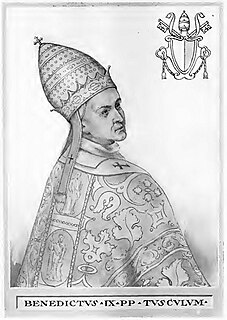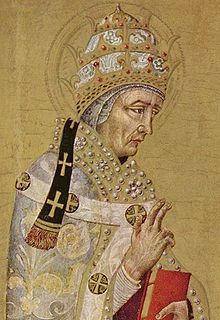
Pope Agapetus II was Pope from 10 May 946 to his death in 955. A nominee of the Princeps of Rome, Alberic II, his pontificate occurred during the period known as the Saeculum obscurum.

Pope Benedict VI was Pope from 19 January 973 to his death in 974. His brief pontificate occurred in the political context of the establishment of the Holy Roman Empire, during the transition between the reigns of German emperors Otto I and Otto II, incorporating the struggle for power of Roman aristocratic families such as the Crescentii and Tusculani.

Pope Benedict VIII reigned from 18 May 1012 to his death in 1024. He was born Theophylactus to the noble family of the counts of Tusculum, descended from Theophylact, Count of Tusculum, like his predecessor Pope Benedict VII (973–974). Horace Mann considered him "...one of the few popes of the Middle Ages who was at once powerful at home and great abroad."

Pope Benedict IX, born Theophylactus of Tusculum in Rome, was Pope on three occasions between October 1032 and July 1048. Aged approximately 20 at his first election, he is one of the youngest popes in history. He is the only man to have been Pope on more than one occasion and the only man ever to have sold the papacy.

Pope Sergius III was Pope from 29 January 904 to his death in 911. He was pope during a period of feudal violence and disorder in central Italy, when warring aristocratic factions sought to use the material and military resources of the Papacy. Because Sergius III had reputedly ordered the murder of his two immediate predecessors, Leo V and Christopher, and allegedly fathered an illegitimate son who later became pope, his pontificate has been variously described as "dismal and disgraceful", and "efficient and ruthless".

Pope Theodore II was Pope for twenty days in December 897. His short reign occurred during a period of partisan strife in the Catholic Church, which was entangled with a period of feudal violence and disorder in central Italy. His main act as pope was to annul the "Cadaver Synod" of the previous January, therefore reinstating the acts and ordinations of Pope Formosus, which had themselves been annulled by Pope Stephen VI. He also had the body of Formosus recovered from the river Tiber and reburied with honour. He died in office in late December 897.

Year 964 (CMLXIV) was a leap year starting on Friday of the Julian calendar.

Pope John XIII was Pope from 1 October 965 to his death in 972. His pontificate was caught up in the continuing conflict between the Emperor, Otto I, and the Roman nobility.
The Diploma Ottonianum was an agreement between Pope John XII and Otto I, King of Germany and Italy. It confirmed the earlier Donation of Pippin, granting control of the Papal States to the Popes, regularizing Papal elections, and clarifying the relationship between the Popes and the Holy Roman Emperors.

Crescentius the Elder was a politician and aristocrat in Rome who played a part in the papal appointment.

Papal appointment was a medieval method of selecting a pope. Popes have always been selected by a council of Church fathers, however, Papal selection before 1059 was often characterized by confirmation or "nomination" by secular European rulers or by their predecessors. The later procedures of the papal conclave are in large part designed to constrain the interference of secular rulers which characterized the first millennium of the Roman Catholic Church, and persisted in practices such as the creation of crown-cardinals and the jus exclusivae. Appointment might have taken several forms, with a variety of roles for the laity and civic leaders, Byzantine and Germanic emperors, and noble Roman families. The role of the election vis-a-vis the general population and the clergy was prone to vary considerably, with a nomination carrying weight that ranged from near total to a mere suggestion or ratification of a prior election.

There was no uniform procedure for papal selection before AD 1059. The Bishops of Rome and Supreme Pontiffs (Popes) of the Catholic Church were often appointed by their predecessors or by political rulers. While some kind of election often characterized the procedure, an election that included meaningful participation of the laity was rare, especially as the Popes' claims to temporal power solidified into the Papal States. The practice of papal appointment during this period would later result in the jus exclusivae, i. e., a right to veto the selection that Catholic monarchs exercised into the twentieth century.

The Tusculan Papacy was a period of papal history from 1012 to 1048 where three successive Counts of Tusculum installed themselves as pope.
The Synod of Rome (963) was a possibly uncanonical synod held in St. Peter’s Basilica from 6 November until 4 December 963, under the authority of the Holy Roman Emperor, Otto I to depose Pope John XII. The events of the synod were recorded by Liutprand of Cremona.


















